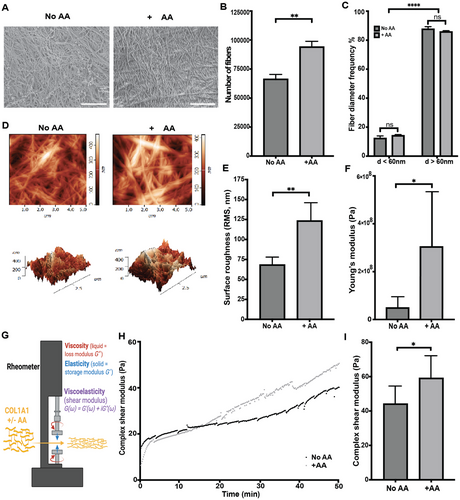Ascorbic Acid Improves the Mechanical Properties of Collagen-Based Matrix
Posted in ISM Stories News Story
A new study led by Micaila Curtis in collaboration with Dr. Xinran Zhang and the Institute for Soft Matter Synthesis and Metrology (ISMSM) amongst others, titled “Ascorbic Acid Improves the Mechanical Properties of Collagen-Based Matrix” and published in Advanced Healthcare Materials, reveals how Vitamin C (ascorbic acid) enhances the structure and mechanical integrity of collagen matrices—even in the absence of cells. The work provides new insights into the extracellular role of ascorbic acid in supporting the physical properties of collagen, the most abundant protein in the human body and the foundation of bone and many other organ systems.
Visualizing Collagen Reinforcement
Image Title: Ascorbic acid improves the mechanical properties of collagen-based matrix
Image Credit: GWNIC, ISMSM (Dr. Xinran Zhang) and Micaila Curtis

The featured image integrates results from scanning electron microscopy (SEM), atomic force microscopy (AFM), and rheological measurements to illustrate how ascorbic acid (AA) alters the collagen matrix on multiple scales.
- SEM images show that the incorporation of AA increases individual fiber formation, creating a denser and more interconnected network.
- AFM images reveal more prominent fiber bundles under +AA conditions, correlating with observed increases in stiffness and surface roughness.
- Rheological analysis demonstrates that the complex shear modulus rises with AA treatment, confirming enhanced viscoelasticity and overall mechanical performance of the collagen matrix.
Together, these findings visualize how a simple biomolecular addition can significantly strengthen a collagen-based material.
Why It Matters
Traditionally, ascorbic acid has been understood as an intracellular cofactor in collagen synthesis. This study challenges that view by showing that AA can also influence collagen polymerization and organization extracellularly—even without cells present. By proving that AA directly enhances matrix stiffness and structure, the research underscores its potential as a key additive for improving biomaterials, scaffolds, and tissue engineering platforms.
These discoveries have strong implications for bone health. Glucocorticoids, commonly prescribed anti-inflammatory drugs, are known to cause osteoporosis with long-term use. This study demonstrates that ascorbic acid can counteract these damaging effects by reinforcing the extracellular matrix and supporting bone microvasculature, suggesting possible new strategies for preventing or treating drug-induced bone loss.
Overcoming Technical Challenges
Capturing these results required precision and innovation. SEM imaging of biological samples demanded careful sample preparation to minimize surface charging, while AFM posed even greater challenges. The team compared wet and dry AFM techniques, experimenting with custom-made colloidal probes before ultimately determining that dry AFM yielded the clearest results for these exceptionally soft samples.
Future Directions
Building on these findings, future research will explore in vivo studies to assess how ascorbic acid–enhanced collagen matrices perform in biological systems. The team also plans to incorporate calcium phosphates to investigate whether AA supports improved bone mineralization and cellular activity.
About the Researcher
Micaila Curtis, a Ph.D. candidate in Dr. Alimperti’s group, has been deeply motivated by both scientific curiosity and personal connection. Her mother’s diagnosis with glucocorticoid-induced osteoporosis inspired her to pursue this line of research. “I’ve always been fascinated by the body’s resiliency to heal,” she says. “This work gave me the chance to explore how something as simple as Vitamin C could be harnessed to strengthen that natural process.”
As Curtis prepares for her thesis defense and a future in medicine, having already been accepted to medical school for 2026, her research bridges fundamental biophysics and clinical potential, reflecting a commitment to translating soft matter science into human impact.
Read the full study in Advanced Healthcare Materials: https://advanced.onlinelibrary.wiley.com/doi/full/10.1002/adhm.202502606
